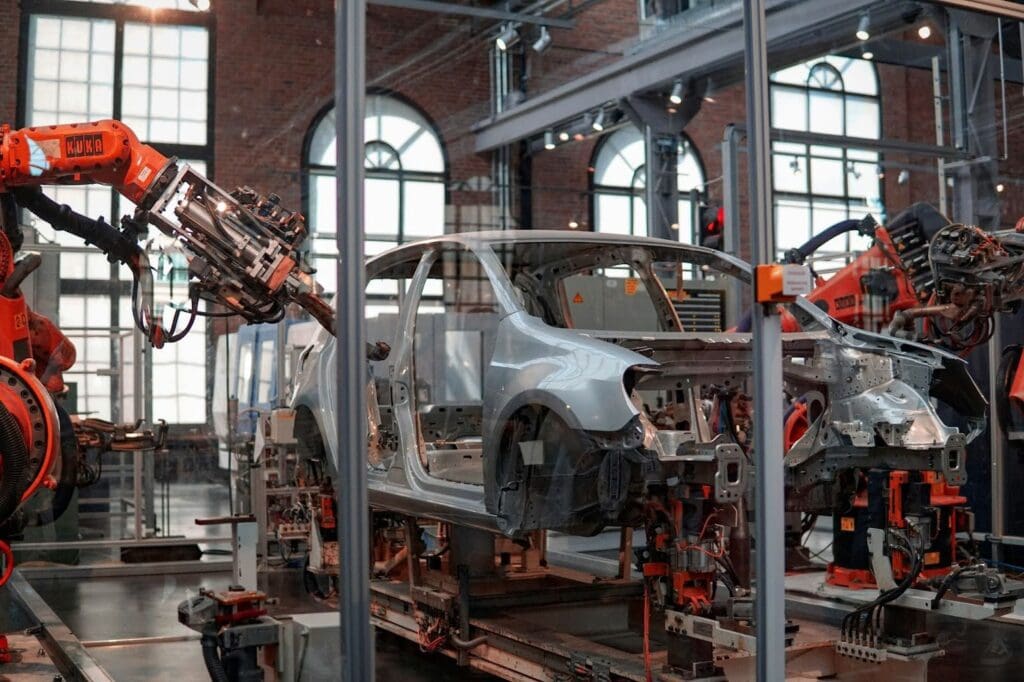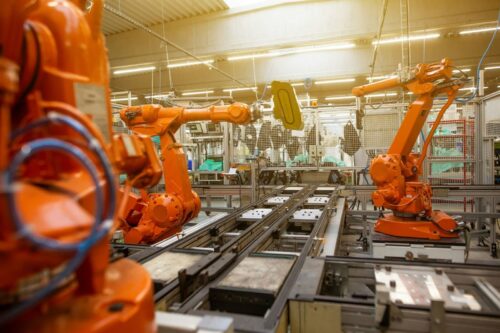Assembly Line: Definition, History, and Advantages

Assembly lines are the backbone of modern manufacturing, revolutionizing how we produce everything from cars to consumer electronics. Why is and why was the assembly line important?
They enable manufacturers to assemble complex products efficiently, drastically transforming traditional production methods. By systematically adding parts at successive stations, these lines optimize time and labor, making large-scale manufacturing feasible and economically viable.
As we delve into the assembly line’s intricate details, its historical evolution (from the industrial revolution until now), and the dual-edged nature of its impact, it becomes clear how this innovation shaped the industrial landscape and set a precedent for future manufacturing techniques.
Understanding the merits and challenges of how assembly line work, provides crucial insights into their pivotal role in shaping industries and economies worldwide. In this article, we will define assembly line and assembly line worker and give a direct line into assembly line meaning.
What is an Assembly Line?
An assembly line is a manufacturing process that constructs a final product more efficiently by adding components sequentially. Each worker or machine on the line performs a specific task repeatedly, and as the product progresses along the line, it gradually comes closer to completion.
This system revolutionized production by dividing labor into manageable, repetitive tasks that significantly speed up manufacturing.
- Automotive Industry: Assembly lines are critical in car manufacturing, where tasks are divided among workers and machines. For instance, one station might install the engine, the next might fit the wheels, and so on, dramatically increasing the number of vehicles produced daily.
- Electronics: In electronics manufacturing, assembly lines help manage the intricate assembly of small, precise components, from smartphones to household appliances, ensuring high accuracy and efficiency.
- Large-Scale Production: Industries such as furniture, clothing, and food processing also utilize assembly lines. Each line segment is designed to handle a specific task contributing to the final product, allowing for mass production under stringent quality control measures.
This method streamlines production and helps reduce labor costs, as each worker specializes in one task rather than the entire product.
With the integration of automated assembly lines tools, companies can further enhance efficiency and reduce human labor, especially in complex manufacturing environments like those found in the automotive and electronics industries.
The History of the Assembly Line
Before assembly lines transformed manufacturing, factories relied heavily on skilled laborers to handcraft entire products from start to finish. This process was not only time-consuming but also limited in terms of production capacity and consistency.
The introduction of assembly lines marked a significant shift, enabling manufacturers to increase the volume and uniformity of the final assembly of their products.
- 1799 – Eli Whitney’s Interchangeable Parts: This concept laid the groundwork for modern assembly lines by demonstrating that unskilled workers could assemble uniform parts to produce a complete product, initially applied to firearms manufacturing.
- 1913 – Ford Motor Company’s Moving Assembly Line: Henry Ford revolutionized the automotive industry by introducing a moving conveyor belt that significantly reduced the time it took to assemble a car. This innovation dropped the assembly time for a Model T from 12 hours to just 1.5 hours, drastically cutting costs and setting a new standard for mass production.
- 1920s – Expansion Across Industries: Following Ford’s success, the assembly line concept quickly spread across various industries, from household appliances to industrial machinery, enhancing productivity and reducing direct labor costs.
- 1950s – Automation Begins: The introduction of automated equipment and robots further enhanced the efficiency of assembly lines, reducing human error and increasing production speeds.
- 1980s – Just-In-Time Manufacturing: Toyota developed this methodology to optimize manufacturing processes by receiving goods only as needed in the production process, reducing inventory costs, and increasing the efficiency of assembly lines.
These milestones highlight how assembly lines have evolved to incorporate advanced technologies and strategies, making them integral to modern manufacturing processes.
They not only save time, create more, and reduce labor costs but also continue to shape how industries operate, ensuring efficiency and quality in production.
Advantages and Benefits of the Assembly Line
Assembly lines revolutionize manufacturing processes, delivering numerous benefits that enhance production capabilities across various industries.
Increased Productivity
Assembly lines enable manufacturers to increase production rates significantly. By dividing the manufacturing process into smaller, manageable tasks, each worker focuses on a specific part of the assembly, making the overall process faster and more efficient.
This specialization allows for quicker turnover and higher output of finished product, rapidly meeting market demands.
Reduced Labor Costs
One of the primary advantages of assembly lines is their ability to minimize the need for skilled labor. Workers on assembly lines typically learn one task or a small set of functions, which reduces training time and cost. Simplifying tasks also allows for a more streamlined workforce, reducing labor costs while maintaining high production rates.
Improved Product Quality
Standardization is a hallmark of the assembly line method. By standardizing the tasks performed at each station, assembly lines consistently ensure that each product component meets quality standards.
This regularity improves the overall quality of the workstation’s final product and reduces the likelihood of defects, leading to greater customer satisfaction and fewer returns or repairs needed.
Challenges and Disadvantages of Assembly Lines
While assembly lines boost efficiency and productivity, they also present specific challenges that can impact the workforce and the adaptability of manufacturing processes.
Worker Dissatisfaction
Jobs on assembly lines often involve repetitive tasks, leading to dissatisfaction among workers. The monotony of performing the same task for hours can decrease job satisfaction, potentially leading to higher turnover rates. Companies need to address these issues proactively to maintain a motivated workforce.
Inflexibility
Assembly lines typically excel in environments where the product and process remain constant. However, they lack flexibility when adapting to new designs, materials, or process changes. This rigidity can result in delays and increased costs as adjustments to the line or retraining of workers might be necessary to accommodate new requirements.
Dependence on Smooth Operation
An assembly line’s efficiency hinges on the smooth functioning of every station. If one part of the production line experiences a disruption, such as a machine breakdown or a supply chain issue, it can halt the entire production process.
Modern Innovations and Future Trends

Recent advancements in assembly line technologies are setting new benchmarks in manufacturing efficiency and precision. Integrating automation and robotics has been particularly transformative, allowing faster, more consistent production with fewer errors.
Automated systems now handle tasks that are either too intricate or too dangerous for human workers, enhancing safety and allowing companies to allocate human resources to more critical areas of operation.
- Robotics in Automotive Assembly: Robots and robotic arms in automotive plants can perform various tasks, from welding to installing tiny components, boosting productivity while ensuring each assembled vehicle meets quality standards.
- AI and Machine Learning: These technologies are being incorporated to predict maintenance needs and optimize production schedules, reducing downtime and enhancing output. Machine learning algorithms can also adapt real-time, automated assembly line operations to meet changing demands without human intervention.
Looking ahead, the future of assembly lines seems poised for even more innovation. Augmented reality (AR) and virtual reality (VR) could provide workers real-time data and analytics, improving decision-making processes and training.
Additionally, the Internet of Things (IoT) expansion is expected to increase connectivity among machines, leading to more intelligent, more responsive manufacturing environments that could overcome many of the traditional limitations of assembly lines.
Conclusion
Assembly lines have fundamentally transformed the manufacturing and business landscape, from initial breakthroughs in the automotive sector to widespread applications across various industries. These systems have enhanced productivity and efficiency, allowing businesses to produce standardized products in large quantities while managing costs effectively.
Despite some challenges, such as worker dissatisfaction and inflexibility, the benefits of assembly lines, including reduced labor costs and improved product quality, continue to make them a vital part of modern manufacturing.
Now equipped with a deeper understanding of assembly lines, you can appreciate their crucial role in historical contexts and in shaping future innovations in manufacturing and other industries.
As industries evolve with new technologies like automation and artificial intelligence, assembly lines will continue to be at the heart of production strategies, driving businesses toward more significant achievements.
